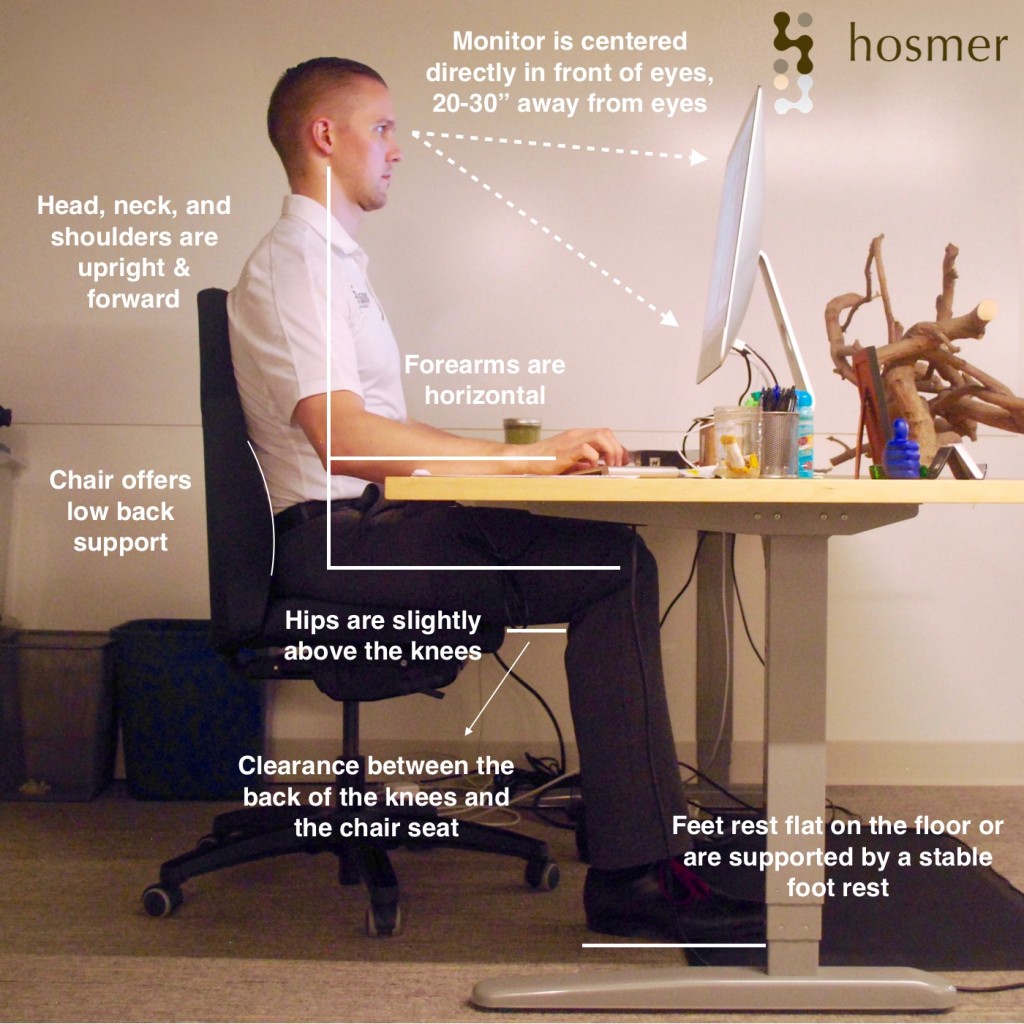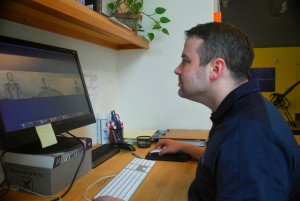
“Sitting is the new smoking,” is one of the common health mantras you may have heard recently. While slightly melodramatic, it is true that prolonged sitting has negative effects on your health. While a rich and varied movement palate is the ideal daily prescription for musculoskeletal health, we recognize that many people are stuck in a situation where they are required to sit most of the day at their job. With that in mind, here are some guidelines for creating the most ideal ergonomic workplace set-up, and some other helpful tips to help negate the effects of sitting. Of course, an ideal situation would be transitioning to an adjustable height workstation. However, if that is not an option, here is what we recommend:
IDEAL WORKSTATION SET-UP
MAINTAINING GOOD POSITION
Once you’ve got the perfect workstation set-up all you have to do it sit, right? Wrong! Getting your workstation set up correctly is only half the battle. You now have to actually sit and maintain a good neutral posture. Here are a few tips and tricks to making the most out of your new workstation.
GOOD POSTURE IS HARD WORK
Sitting with proper posture may feel awkward and tiring for a while, especially if you are a person who has chronic poor posture. If you have been sitting with poor posture for years, it’s going to take some time to undo some the damage you’ve done; plus, you are going to be using postural muscles that haven’t been used in a while and it’s going to take time for them to strengthen and adapt to proper positioning. One of the biggest complaints from people new to sitting or standing with good posture is that they get tired, sore, and are unable to maintain position. This is perfectly normal!
Just like any exercise program, the best way to combat this is through slow progressive jumps. Start easy by consciously sitting with good posture for just one minute. Once that becomes easy, increase the time to two minutes and so on. It’s going to take a few weeks for you to build up the strength and endurance to maintain this position for an entire day.
JUST BREATHE!!
Faith Hill can’t be wrong. Make sure you are breathing correctly. One of the quickest ways to sabotage good posture is to take short shallow breaths with your chest. This breathing pattern is not only inefficient, but also will fatigue the postural muscles that are already working hard on keeping you sitting upright. For a detailed explanation of proper breathing mechanics, please see our video on breathing or our other blog post on proper breathing and bracing techniques.
BE MINDFUL
Proper posture is one of the easiest things to learn, but one of the hardest things to maintain. Barring any major medical condition, I have yet to meet any individual who is physically incapable or not strong enough to sit up straight. Posture is one of those annoying things that you have to constantly practice until it becomes a new ingrained habit.
Yes, it is hard.
Yes, it takes time.
Yes, it is one of the cheapest and easiest things you can do to maintain long-term spine health.
Yes, we know you are busy – everyone is. Find time because after all, it’s your body and your health.
The key to success is simply finding a way to remind yourself to check your posture and breathing on a regular basis. One thing that many patients find helpful is setting an alarm on their phone that goes off every hour that reminds them to sit up straight and breathe. Others like putting a post-it note on the corner of their computer screen. Oftentimes tying it to another ingrained behavior will increase your chances of success, such as resetting your posture every time you check your email, or checking your breathing mechanics every time the phone rings. It doesn’t matter how you do it, but find a way to remind yourself multiple times a day. The good thing is that the more you do it, the easier it becomes, and soon you won’t even have to think about it. The patients we see respond the best and quickest here at the clinic are those who are doing their home care exercises and stretches (include working on their posture!). It slows progress when we see patients leaving and “undoing” the very same things our team is working so hard on when you come in for treatment.
Finally, here are a few other tips and tricks that will help you in your quest for perfect posture.
- Increase the font size on documents and use the zoom-in feature when on the internet. This will help to
“Chicken Neck”
decrease the “chicken neck” position.
- If you are using a laptop, use a separate keyboard and mouse so you can have your screen at eye level and your mouse and keyboard at elbow level.
- If you are on the phone all day, use a headset instead of trying to cradle to phone between your ear and shoulder. Your neck will thank you.
- Give your eyes a break! Desk workers spend most of their day using a close-up vision field, and the muscles of the eyes, just like any other muscles get fatigued as well. When taking breaks, make sure to spend at least ten seconds focusing on objects across the room or far away outside. This will give your near- vision field a bit of a break. Also, move your eyes in slow, full circles to the extreme edge of your vision. Most people lose visual acuity as they age and doing some of these simple drills will keep your vision sharp and improve your balance. Just don’t roll your eyes in front of your boss.
- Look into the possibility of getting a standing desk or custom-designed ergonomically fitted work chair. Many companies offer this as a perk to their employees, and it never hurts to ask. In some cases, we can make medical recommendations to employers for standing desks. Please ask your doctor for details.
- Keep in mind that you don’t have to stand all of the time. Many standing desks raise are adjustable so you can keep a stool nearby for when you need a break or some extra brainpower. Choosing your health doesn’t have to break the bank, either; check out this list of adjustable desks that the researchers at Consumers Advocate have put together to see some of the options out there.
- The important thing is to figure out what works for you.
Finally, and most importantly TAKE A BREAK AND MOVE!! Even with the most ideal sitting or standing posture, it is still important to get up at least once an hour and move. The body was not designed to stay in the same position for prolonged periods of time, and the best thing you can do is give it a rest. This can be as simple as getting up and walking to the water cooler, walking across the office to chat with a co-worker instead of using IM, doing some stretches, etc. Even if you are swamped and can’t take long breaks, standing up and stretching for a few seconds will still do you some good. Anything you can do to break the monotony of the sitting posture will have positive effects on your body.
Now that you’ve been sitting for a while reading this article, get up and go do some push-ups.

